Diabetes: Presentation Objectives
- Introduce diabetes as a serious public health burden in the United States.
- Provide statistical background.
- Learn current diagnostic and treatment methods for diabetes.
- Investigate recent interventions in treating diabetes.
- Understand how to apply a nursing theory in clinical practice.
This presentation is about diabetes, its types, diagnoses, and treatment interventions. At the end of this presentation, the audience will be able to:
- Understand diabetes as a serious public health burden in the United States and describe its main symptoms, causes, and treatment details;
- Use statistical data on the disorder;
- Investigate different current diagnostic and treatment methods for diabetes;
- Evaluate recent interventions in treating diabetes;
- Apply a nursing theory in clinical practice in order to treat diabetes and provide patients with a possibility to prevent this disorder.
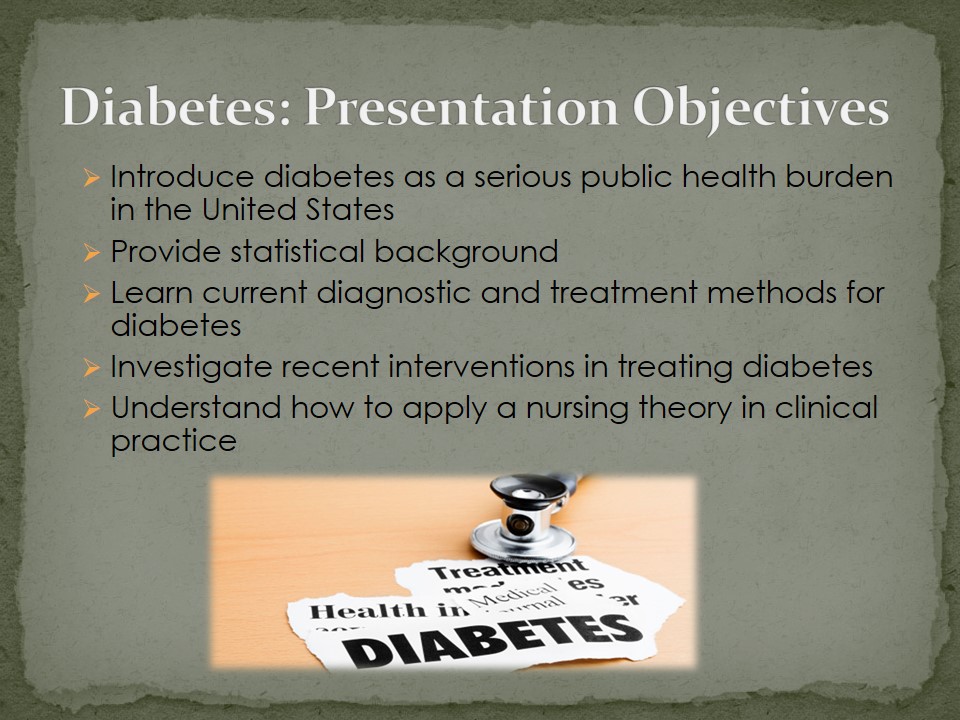
Diabetes Basics
- What: A metabolic disorder group that is characterized by a high level of sugar in the blood.
- Types: Type I, Type II, Gestational.
- Symptoms: frequent urination, thirst, weight loss, fatigue, blurred vision.
- Causes: the immune system destroys cells that produce insulin in the pancreas.
Diabetes is a serious public health concern that introduces a group of metabolic disorders caused by changes in the sugar blood level. There are three main types of this disorder (American Diabetes Association, 2014):
- Type I – a disorder caused by an absolute insulin secretion deficiency;
- Type II – a disorder caused by insulin resistance and an inadequate insulin secretory response;
- Gestational diabetes –a disorder that is characterized by high blood sugar during pregnancy.
The main symptoms include frequent urination, increased thirst, unexplainable weight loss, fatigue, and blurred vision. Still, the list of symptoms is not complete, and each type of diabetes has its own symptoms such as depression, anxiety, and frequent infections (Boyanova & Mitov, 2013). Almost all symptoms result from the main cause of this disorder, which is the destruction of insulin-producing cells in the pancreas by the immune system.
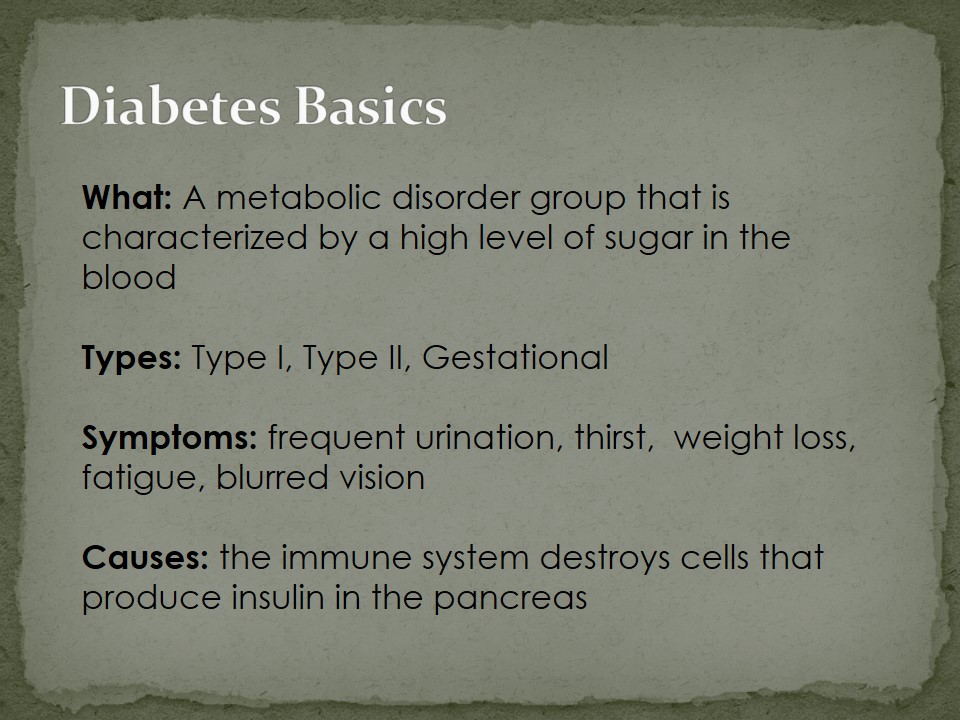
Diabetes: Epidemiology
- Number of people with diabetes:
- 30.3 million Americans have diabetes (9.4%);
- 1.25 million children have diabetes;
- 7.2 million people are not diagnosed (not aware);
- 1.5 million new cases occur annually;
- 84.1 million people are pre-diabetic.
- Number of deaths due to diabetes:
- Under 20 years – 193,000 deaths;
- 17,900 – Type I;
- 5,300 – Type II.
- Risk factors for diabetes:
- Family history, diet, weight, inactivity, high blood pressure;
- Age: >18, Race: American Indians, Hispanics and Blacks.
According to the National Report of the Centers for Disease Control and Prevention (2017), diabetes afflicts 9.4% of the US population. The number of people who have diabetes increases regularly, including the number of people who remain unaware of having the disease. In addition to the fact that 30.3 million Americans have diabetes (Type I or II), there are approximately 84.1 million who are pre-diabetic. Diabetes is the seventh leading cause of death among Americans and it takes about 193,000 lives annually (Tucker, 2017). People should be aware of such risk factors for diabetes as family history, poor diets and inactivity that lead to overweight and obesity (fatty tissue promotes a high resistance of cells to insulin), and high blood pressure or glucose (Ferrannini & Cushman, 2012). People under 18 years who are American Indians, Hispanics and non-Hispanic Blacks are more likely to have different forms of diabetes.
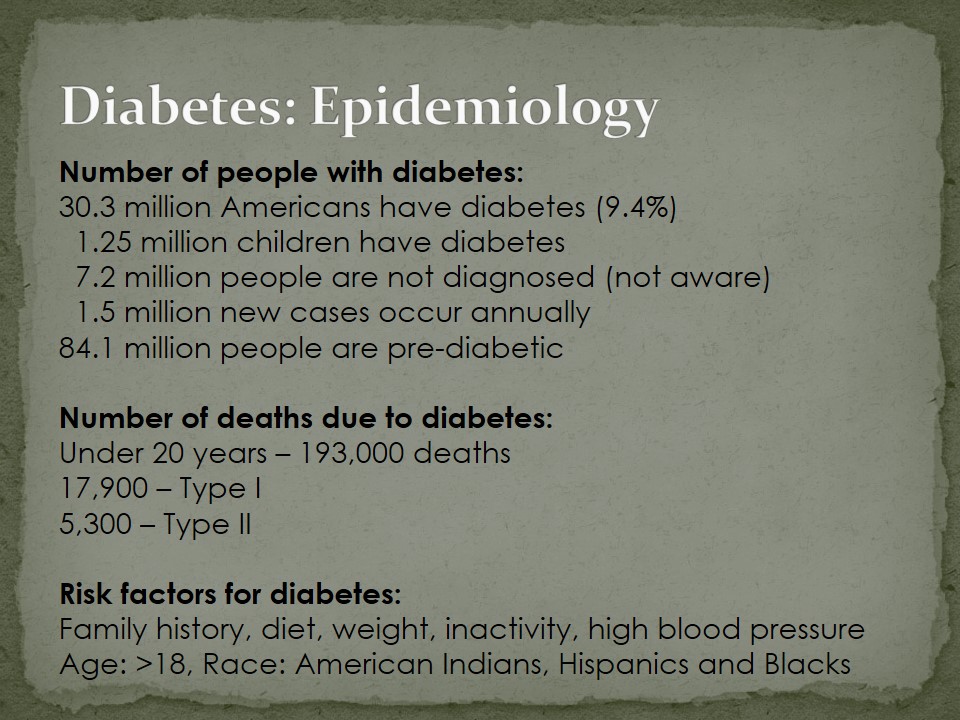
Diagnosis of Diabetes
- A1C – Glycated hemoglobin test.
- RPG – Random plasma glucose test.
- FPG – Fasting plasma glucose test.
- OGTT – Oral glucose tolerance test.
If people have a BMI more than 25, and they are older than 45, it is recmmended to take a test for diabetes regularly. There are four main tests that can be offered to patients for diagnosis (American Diabetes Association, 2014; Ferrannini & Cushman, 2012):
- A1C (Glycated hemoglobin test): indicates an average blood glucose level over the last three months (5.7% – normal, 5.7-6.4% – pre-diabetic, 6.4%> – diabetic);
- RPG (Random plasma glucose test): measures blood glucose level, can be taken anytime, fasting is not usually required (200 mg/dL> – diabetic);
- FPG (Fasting plasma glucose test): measures blood glucose level, has to be taken in the morning, fasting period is at least eight hours (126 mg/dL> – diabetic);
- OGTT (Oral glucose tolerance test): indicates a level of sugar in the blood, has to be taken annually, fasting during the last eight hours (140 mg/dL – normal, 140-199 mg/dL – pre-diabetic, 199 mg/dL> – diabetic.

Diabetes: Treatment Interventions
- Routine Activities:
- Blood sugar/glucose monitoring;
- Insulin monitoring;
- Non-Pharmacological Treatment:
- Healthy diet;
- Physical exercises;
- Lifestyle changes.
- Pharmacological Treatment:
- Insulin;
- Metformin;
- Sulfonylurea;
- Alpha-glucosidase inhibitors;
- Pioglitazone.
In scholarly articles, much attention is paid to different methods of treatment that can be offered to patients with diabetes. For example, despite the type of diabetes, patients have to follow several routine tests, such as monitoring and control of the level of blood sugar, glucose, and insulin. Any change should be reported to a physician or a nurse (Tucker, 2017).
Non-pharmacological treatment may include: the necessity to keep to a healthy diet, engage in physical exercise regularly (if age allows), and consider certain lifestyle changes (American Diabetes Association, 2014).
Pharmacological treatment should be based on taking medications from such groups as insulin (a hormone that controls the level of sugar in the blood), metformin (an antihyperglycemic agent that improves glucose tolerance in the blood), sulfonylurea (a hormone that controls the level of sugar in the blood), alpha-glucosidase inhibitors (promote blood glucose concentration), and pioglitazone (decreases the level of blood sugar) (Pradeep & Haranath, 2014).

Research Article on Diabetes
- Article: Roumie et al. (2014) on treatment of diabetes patients with metformin, insulin, and sulfonylureas.
- Method: Retrospective cohort; medical records of veterans who are treated with metformin, insulin, and sulfonylurea.
- Strengths: Evaluation of different pharmacological treatment methods, insulin-associated risks, and cardiovascular outcomes.
- Weaknesses: Attention to refill data only, sample size, and the presence of difficult-to-measure factors.
- Future Implications: Deep investigation on risks associated with insulin use.
The article for analysis was published in JAMA in 2014. Its title is “Association between intensification of metformin treatment with insulin vs. sulfonylureas and cardiovascular events and all-cause mortality among patients with diabetes.” Roumie et al. (2014) aim to investigate diabetes medications, including insulin, metformin, and sulfonylurea, and to compare the time to acute myocardial infarction, stroke, or death among patients. The research method is a retrospective cohort of the Veterans Health Administration, Medicare, and National Death Index databases from 2001 to 2008. The strong points of this article include the possibility of evaluating the effects of different medications on patients with diabetes, identifying treatment outcomes that may be avoided, and investigating insulin-related risks. The authors admit such limitations as difficult-to-measure factors (patient frailty or diabetes severity), the chosen sample size, and the usage of refill data only (Roumie et al., 2014). It is suggested to use the results of this investigation in new research on cardiovascular risks associated with diabetes.
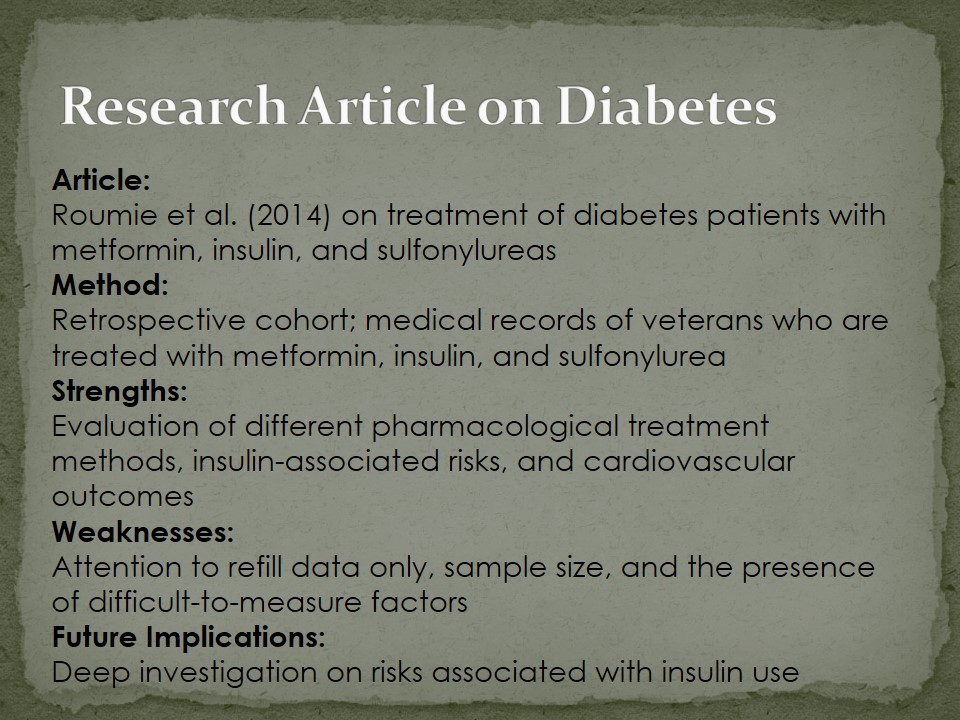
Nursing Theory: Basics
Roy’s Adaptation Theory:
- Physical and psychological adaptability => life quality;
- Goal of nursing => adaptation;
- Person => adaptive system;
- Environment => reasons for adaptation;
- Health => outcome of adaptation;
- Nursing => means of adaptation.
Callista Roy is a nurse theorist and writer who introduced her Adaptation theory in 1989. According to this theory, all individuals are bio-psycho-social beings who have to improve their physical and psychological adaptability, which can influence the quality of their lives. This theory aims at promoting adaptation as the only way to maintain constant interaction with the environment. The success of adaptation depends on how well patients and nurses are able to use their conscious awareness and take correct steps. A patient has to develop an appropriate adaptive system in terms of which all internal and external environmental changes (as stimuli for adaptation) can be interpreted correctly. Health is the main outcome of an adaptive process, and nurses have to support and educate patients on how to cope with health problems and challenges.
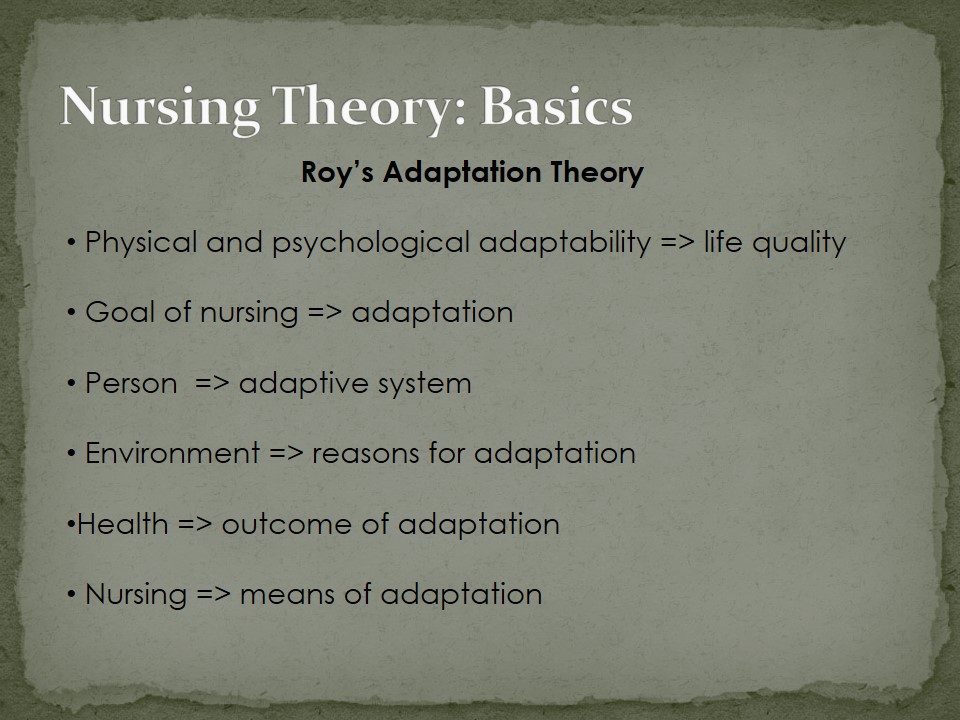
Nursing Theory: Application
- WHY:
- Diabetes is a chronic disease.
- Patients have to adapt to it.
- Diabetes treatment includes lifestyle changes.
- Integration and adaptation are integral points.
- HOW:
- Life with diabetes is full of fears, conflicts, and anxiety.
- Balance is supported by Roy in her adaptation theory.
- Balance is what diabetes patients may need.
- New improvements and changes are required.
Roy’s adaptation theory may be a helpful tool in treating patients with diabetes due to the fact that it is based on the idea of adaptation to environmental changes. Diabetes is a chronic disease that can go away in a short period. Patients have to know how to live with this disease, what changes should be considered, and what treatment is appropriate. Nurses and doctors offer an integration of lifestyle, diet, activities, and medications to control the level of sugar in the blood. This theory helps patients to accept the fact that a new life with diabetes may be full of fears, conflicts, anxiety, and uncertainty. Adaptation offers a possibility for finding balance. Changes may be not enough, and adaptation can be an answer.

How to Improve Patient Outcomes
- Self-management education.
- Promotion of behavioral changes.
- Nutritional improvements.
- Planning, monitoring and control.
- Cooperation between a patient and a health care provider.
- Medication importance.
- Readiness for adaptation.
Based on Roy’s adaptation theory, the research of Roumie et al. (2014), and the analysis of scholarly articles, several ways to improve diabetes patient outcomes may be identified.
- Self-management education (nurses and other health care providers should educate their patients about the importance of changes as soon as they are diagnosed with diabetes);
- Promotion of behavioral changes (changes have to be explained and supported);
- Nutritional improvements (diets must support healthy outcomes);
- Planning, monitoring and control (sugar and glucose level in the blood should be checked regularly);
- Cooperation between patients and health care providers (patients must understand that they can turn to their health care providers anytime they need help or an explanation of a disease-related problem);
- Importance of medication (insulin is a medication that cannot be neglected);
- Readiness for adaptation (patients have to accept new rules and requirements).
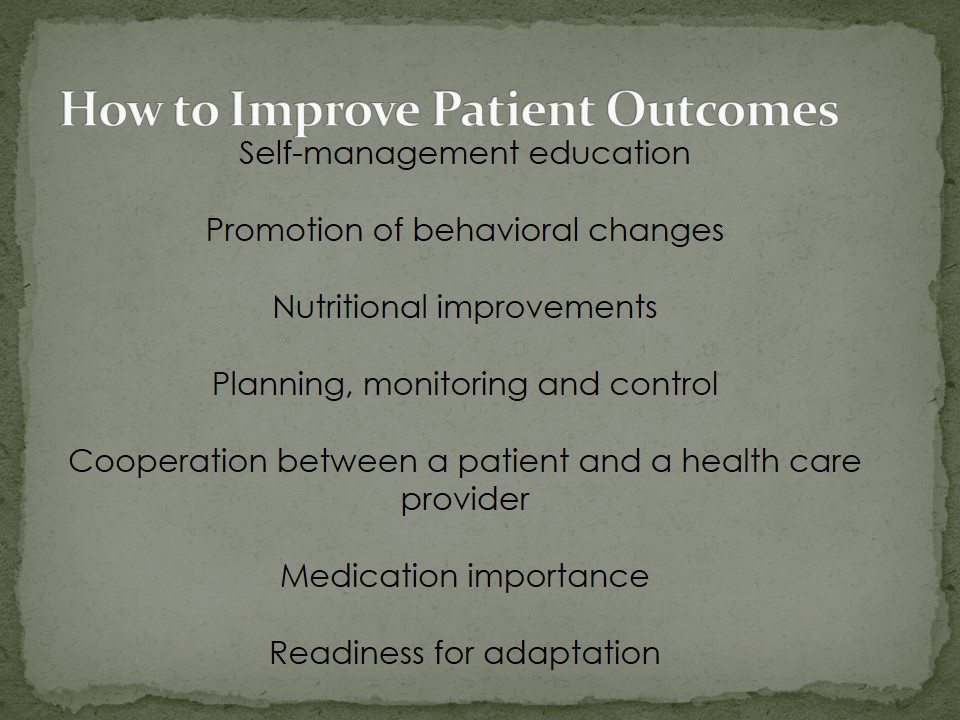
Conclusion
- Diabetes is a chronic disease that touches upon millions of American lives.
- Diagnoses and treatment cannot be neglected by diabetes patients.
- Insulin is the main treatment.
- Health care providers have to support their patients.
- Adaptation is a solution for diabetes patients.
- Diabetes may kill, and people should treat it properly.
At the end of this presentation, the following conclusions can be made:
- Diabetes is a serious public health concern that touches millions of American lives and is caused by a high level of sugar in the blood.
- More than 193,000 people die due to diabetes annually.
- Diagnosis (A1C, FPG, RPG, OGTT) and treatment (physical activities, diets, medications such as insulin) are important for patient care.
- Health care providers are responsible for patient education and support.
- Roy’s theory of adaptation can be used to explain the possibility of coping with health challenges and lifestyle changes caused by diabetes.
- Diabetes can kill, and early diagnosis is a way to save lives.

References
American Diabetes Association. (2014). Diagnosis and classification of diabetes mellitus. Diabetes Care, 37(1), 81-90.
Boyanova, L., & Mitov, I. (2013). Antibiotic resistance rates in causative agents of infections in diabetic patients: Rising concerns. Expert Review of Anti-Infective Therapy, 11(4), 411-420.
Centers for Disease Control and Prevention. (2017). National diabetes statistics report. Web.
Ferrannini, E., & Cushman, W. C. (2012). Diabetes and hypertension: The bad companions. The Lancet, 380(9841), 601-610.
Pradeep, T., & Haranath, C. (2014). A review on diabetes mellitus type II. International Journal of Pharma Research & Review, 3(9), 23-29.
Roumie, C. L., Greevy, R. A., Grijalva, C. G., Hung, A. M., Liu, X., Murff, H. J., … Griffin, M. R. (2014). Association between intensification of metformin treatment with insulin vs sulfonylureas and cardiovascular events and all-cause mortality among patients with diabetes. JAMA, 311(22), 2288-2296.
Tucker, F. M. (2017). America’s diabetes crisis: There is no reason! Exigence, 1(1). Web.